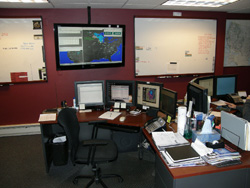The Single European Sky (SES) is a European Commission initiative that seeks to reform the European air traffic management system through a series of actions carried out in four different levels with the aim of satisfying the needs of the European airspace in terms of capacity, safety, efficiency and environmental impact.

ETOPS is an acronym for Extended-range Twin-engine Operations Performance Standards—a special part of flight rules for one-engine-inoperative flight conditions. The International Civil Aviation Organization (ICAO) coined the acronym for twin-engine aircraft operation in airspace further than one hour from a diversion airport at the one-engine-inoperative cruise speed, over water or remote lands, or on routes previously restricted to three- and four-engine aircraft.

In most countries one is required to obtain a glider pilot license (GPL) or certificate before acting as pilot of a glider. The requirements vary from country to country.

The Civil Aviation Authority (CAA) is the statutory corporation which oversees and regulates all aspects of civil aviation in the United Kingdom. Its areas of responsibility include:
A commercial pilot licence (CPL) is a type of pilot licence that permits the holder to act as a pilot of an aircraft and be paid for their work.

The European Union Aviation Safety Agency (EASA) is an agency of the European Union (EU) with responsibility for civil aviation safety. It carries out certification, regulation and standardisation and also performs investigation and monitoring. It collects and analyses safety data, drafts and advises on safety legislation and co-ordinates with similar organisations in other parts of the world.
Pilot licensing or certification refers to permits for operating aircraft. Flight crew licences are issued by the civil aviation authority of each country, which must establish that the holder has met minimum knowledge and experience before issuing licences. The licence, along with the required class or type rating, allows a pilot to fly aircraft registered in the licence issuing state.

The European Organisation for the Safety of Air Navigation, commonly known as Eurocontrol, is an international organisation working to achieve safe and seamless air traffic management across Europe. Founded in 1960, Eurocontrol currently has 41 member states and is headquartered in Brussels, Belgium. It has several local sites as well, including an Innovation Hub in Brétigny-sur-Orge, France, the Aviation Learning Centre (ALC) in Luxembourg, and the Maastricht Upper Area Control Centre (MUAC) in Maastricht, the Netherlands. The organisation employs approximately two thousand people, and operates with an annual budget in excess of half a billion Euro.

A flight dispatcher assists in planning flight paths, taking into account aircraft performance and loading, enroute winds, thunderstorm and turbulence forecasts, airspace restrictions, and airport conditions. Dispatchers also provide a flight following service and advise pilots if conditions change. They usually work in the operations center of the airline. In the United States and Canada, the flight dispatcher shares legal responsibility with the commander of the aircraft.
The Safety Assessment of Foreign Aircraft Programme is a programme established by the European Civil Aviation Conference (ECAC). Within the SAFA programme, ramp inspections made by the regulatory authorities in the member states have a common format.

In aviation, airworthiness is the measure of an aircraft's suitability for safe flight. Initial airworthiness is demonstrated by a certificate of airworthiness issued by the civil aviation authority in the state in which the aircraft is registered, and continuing airworthiness is achieved by performing the required maintenance actions.

A type rating is an authorization entered on or associated with a pilot license and forming part thereof, stating the pilot's privileges or limitations pertaining to certain aircraft type. Such qualification requires additional training beyond the scope of the initial license and aircraft class training.
EU OPS is a European Union (EU) regulations specifying minimum safety and related procedures for commercial passenger and cargo fixed-wing aviation. The legislation is known officially as Council Regulation (EEC) No 3922/91 on the harmonisation of technical requirements and administrative procedures in the field of civil aviation.

General aviation (GA) has been defined as a civil aircraft operation other than a commercial air transport flight operating to a schedule. Although the International Civil Aviation Organization (ICAO) excludes any form of remunerated aviation from its definition, some commercial operations are often included within the scope of General Aviation (GA). General aviation refers to all flights other than military and scheduled airline flights, both private and commercial.
A civil aviation authority (CAA) is a national or supranational statutory authority that oversees the regulation of civil aviation, including the maintenance of an aircraft register.
The Joint Aviation Requirements (JAR) were a set of common comprehensive and detailed aviation requirement issued by the Joint Aviation Authorities, intended to minimise Type Certification problems on joint ventures, and also to facilitate the export and import of aviation products.
The Unmanned Aerial Vehicle Systems Association (UAVS) was created in 1998 when key individuals from Matra-BAe Dynamics-Alenia (MBDA), British Aerospace (BAe) and Remote Services recognised that the United Kingdom UAV industry did not have a collective voice or representative in industry's interface with government and the regulators.
The International Association of Aviation Personnel Schools is a worldwide association of pilot schools. The organization was created on 25 October 1995, and was later renamed in 2009 to also include aviation schools not located in Europe.

A pilot logbook is a record of a pilot's flying hours. It contains every flight a pilot has flown, including flight time, number of landings, and types of instrument approaches made. Pilots also log simulator time, as it counts towards training.
Aviation in the European Union and the European Free Trade Association is regulated by the European Union Aviation Safety Agency (EASA). EASA specifies common standards for the licensing of aircraft pilots. EASA does not issue licences, rather licences are issued by member states. However, because the same standards are used, EASA licences are recognised by all member states.









